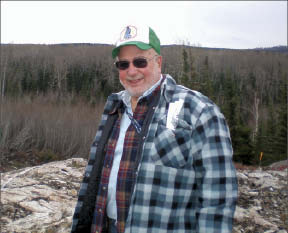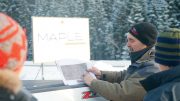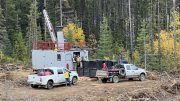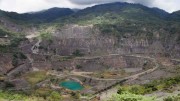With so many gold juniors vying for investor’s attention, it can be an ever more daunting task separating out the projects that will outshine the rest.
Since assessing exploration projects has always been a relative game, projects that meet with market success are generally the ones that show-off some advantage, some unique aspect, that makes them stand-out from their peers.
For Northern Gold Mining (NGM-V) that advantage is size and consistency of results.
While it is still early days, Northern Gold has managed to release a steady stream of long intercepts with consistent grades from its Garrcon deposit, and those results have the company’s president and chief executive Martin Shefsky confident that the project will deliver serious tonnage.
“There is a lot of similarities between what Osisko Mining’s Canadian Malartic was finding in its early days and this,” Shefsky says, as he stands on an outcrop which overlooks the pine green valley overlying the mineralized rocks at Garrcon. “We’ve already outlined roughly 700,000 oz. of gold and that’s just from 20 million tonnes of a deposit that we believe contains over 125 million tonnes… and that’s just going down to the 200-metre level.”
Last September A.C.A. Howe International compiled the first resource estimate on Garrcon which outlined indicated resources of 3.8 million tonnes grading 1.2 grams gold for 144,000 oz. and additional inferred resources of 18.5 million tonnes of 0.9 gram for 530,000 oz. gold.
Not a bad first pass, and considering that none of the 41 holes and 10,114 metres of drilling done in 2010 were included in that estimate, Garrcon could be set to grow in stature just as the snow begins to melt.
That’s because Northern Gold plans to update its resource estimate in March and results from last year’s drilling point to a significant boost on the horizon.
Some of the highlight intercepts released over the course of the year include: 102.5 metres grading 1.38 grams gold, 84.2 metres at 1.49 grams gold, 20 metres at 6.74 grams gold, 190 metres at 1.1 grams gold, 220 metres at 0.69 gram gold and 101 metres at 1.07 grams gold.
Its most recent drill results, released on Feb. 22, did not break the pattern as a highlight hole assayed 58 metres at 1.08 grams gold per tonne.
Such good results come as no surprise to Shefsky.
That’s because, while past drilling by previous operators outlined the boundaries of the deposit, drilling was done in a roughshod fashion with no real consistent pattern, leaving Northern Gold the task of filling in the blanks.
“There’s lots of open areas,” Shefsky says of the deposit. “The 20 million tonnes in the resource estimate is spread out over the whole area, so we have a lot of infill drilling to do. We’re not exploring, we’re just infilling.”
The area that the company is infilling is roughly 760 metres by 300 metres wide and has four separate and large outcrop zones which allowed Northern Gold to run extensive and inexpensive channel samples to guide the drills.
But while the company tightens the drilling and heightens its understanding of the deposit, another intriguing aspect to the geological story lies undisturbed beneath.
That is because the current resource, and the updated resource to come, consider only potential ore between surface and the 200-metre level.
With so much near-surface mineralization, Northern Gold has had little need to go any deeper as any future open pit would have ample material from the 200-metre level up, for many years.
But in the long-term, the mineralization at depth becomes a prominent piece of the story.
Just what lies deeper down has been hinted at via historical holes drilled by Lac Minerals and ValGold Resources (VAL-V). Several of those 52 historic holes went below the 500-metre level and returned grades similar to those and sometimes greater than what Northern Gold has encountered closer to surface.
“We’re not focused on the deeper mineralization at this point, that’s the blue sky here,” Shefsky says. “But assuming that mineralization is consistent with what’s closer to surface, we could be looking at 250 million to 300 million tonnes. But we’ll let people do their own math.”
The bounty of mineralization that Garrcon already boasts, and could still yet yield, may come as less of a surprise once its setting is considered.
Northern Gold seems to have taken the old real-estate adage that the three most important factors in an investment are location, location and location to heart, as the Garrison project, which Garrcon is a part of, sits in one of Canada’ prime
gold-producing regions.
Located on the Destor-Porcupine fault system, the 3.75 sq. km property hosts one of the world’s most prolific gold-producing shears, accounting for more than 180 million oz. of production or 70% of all the gold ever produced in Canada.
More specifically, Garrison sits 40 km north of Kirkland Lake and 100 km east of Timmins, Ont., with St Andrew Goldfields‘ (SAS-T) Holt McDermott and Harker-Holloway mines sitting 15 km to the east, and Brigus Gold‘s (BED-T, BRD-X) Black Fox mine sitting 30 km to the west.
Like Holloway, Garrison has the particular benefit of sitting astride two major shear systems, both of which are spatially related to major gold deposits from west of Timmins to east of Val d’Or, Que.
The two shear systems were formed out of the Munro fault, splaying into the north wall of the Destor Porcupine system on the eastern boundary of the property.
Northern Gold was able to land such prime real estate through a shrewd deal it closed with ValGold in September 2009, which gives it the option to take an 80% stake in Garrison over eight years.
The initial purchase price for the option was just $25,000 in cash and 2.2 million Northern Gold shares, which were valued at just 8¢ a share at the time.
Northern also agreed to pay another $200,000 at the one year anniversary mark – which has already been paid – and additional exploration and stock and cash payments over the years.
To get a 50% interest, for instance, Northern Gold will have to pay another $1 million and complete $4 million in exploration work. It has the option to make those payments in stock or cash.
The final 30% would come via Northern Gold repeating the same payments and when, and if, it hits the 80% mark, the option agreement converts to a joint venture with Northern remaining as the operator.
With all the success that Northern has had with the drill, it should come as little surprise that it is ahead of schedule on such commitments. In 2010, the first year of the deal, Northern Gold was only required to spend $500,000 on exploration, but wound up spending in the neighbourhood of $3 million.
And while the low-cost, high-tonnage potential that Garrcon offers would be the envy of many juniors, the deposit isn’t the only defined mineralization at Garrison.
The property is blessed with a second deposit which sits just a few hundred metres north of Garrcon and is known as the Jonpol deposit.
In contra-distinction to the quartz pyrite vein stockworks at Garrcon, Jonpol is made up of four contiguous high-grade, sulphide-rich narrow vein zones.
The difference in mineralization, despite the deposits’ relative proximity, is due to Jonpol’s sitting right in the sheared ultramafic volcanics of the Munro fault zone.
Garrcon, by comparison, sits in a zone of metasediment that rests between the Munro shear and the Porcupine Destor fault zone.
Mineralization at Jonpol comes from four contiguous mineralized zones with a strike length of 1.7 km. The zones are all open to depth with the deepest mineralization to date being struck at the 600-metre level.
And while Garrcon grabs most of the attention today, that
wasn’t always the case.
Between 1985 and 2007, when the project was held by Cominco and then ValGold, Jonpol was the apple of the operators’ eyes and saw over 112,000 metres of drilling.
A 184-metre shaft was also sunk in the mid-1990s and a ramp was built down to the 150-metre level that allowed Hillsborough Resources to mine a 50,640-bulk sample that graded 8.3 grams along 141 metres of continuous mineralization with an average width of 3.6 metres.
Such a rich history at Jonpol meant that when Northern Gold came on the scene, the deposit already had a resource that merely had to be updated by the company.
That resource currently stands at 253,100 tonnes at 7.77 grams gold for 63,200 oz. in the indicated category with another 1.6 million tonnes grading 4.93 grams gold for 246,540 oz. in the inferred category.
Despite such promising grades, Shefsky affirms that Northern Gold’s focus is on Garrcon, and that he sees Jonpol as a deposit that could come on-stream later to provide high-grade material to a future mill at the site.
In the more near-term, Northern Gold will continue to stay on top of the deposit by re-logging and assaying existing core. Surface and underground drilling are also being considered for later this year.
Possible drawbacks
With such managerial confidence centred on the near-surface tonnage to be outlined in the coming years at Garrcon, investors may well be trying to punch holes into Northern Gold’s thesis.
One area where many projects can go awry is on the metallurgy, as a project can host a fantastic orebody only to be tripped up by high costs and other complications on the extraction side.
But here Northern Gold would appear to have a handle on things.
On Feb. 24, the company announced it had finished a metallurgical test program at the scoping study level.
Conducted by SGS Minerals Services using only ore from Garrcon, the tests confirmed that Northern Gold should have little problem achieving high gold recovery grades.
The testing showed that a combination of gravity recovery plus cyanidation of the gravity tails and cyanidation of the whole ore achieved the best recoveries, exceeding 97% on all four tests that were conducted.
The results also showed that there are no other metals in concentrations high enough to be of any significance.
By demonstrating the free milling nature of mineralization at Garrcon, Northern Gold passed another significant marker in its drive to develop a large open-pit bulk mineable operation.
“We’ll incorporate the metallurgy into the preliminary economic assessment study that will come out with the updated resource at the end of the (first) quarter,” Shefsky says.
“Everything is coming together beautifully. The picture we are painting is that we will go into production as we are taking all of the hurdles and all of the questions out of the equation. And with the resource update coming out, we will have the whole picture out there.”
Whether it’s a picture that will allow investors to see the faint image of Osisko Mining‘s (OSK-T) Canadian Malartic in it remains to be seen, but in a high gold price environment, it is a picture that is certain to attract some long hard stares.






Be the first to comment on "Northern Gold drilling for Ontario’s next big gold mine"